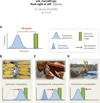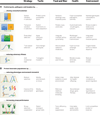Applying evolutionary biology to address global challenges
- PMID: 25213376
- PMCID: PMC4245030
- DOI: 10.1126/science.1245993
Applying evolutionary biology to address global challenges
Abstract
Two categories of evolutionary challenges result from escalating human impacts on the planet. The first arises from cancers, pathogens, and pests that evolve too quickly and the second, from the inability of many valued species to adapt quickly enough. Applied evolutionary biology provides a suite of strategies to address these global challenges that threaten human health, food security, and biodiversity. This Review highlights both progress and gaps in genetic, developmental, and environmental manipulations across the life sciences that either target the rate and direction of evolution or reduce the mismatch between organisms and human-altered environments. Increased development and application of these underused tools will be vital in meeting current and future targets for sustainable development.
Copyright © 2014, American Association for the Advancement of Science.
Figures




References
-
- Ecosystems and Human Well-being: Synthesis. Washington, DC: Island Press; 2005. Millennium Ecosystem Assessment.
-
- Palumbi SR. Evolution - Humans as the world's greatest evolutionary force. Science. 2001;293:1786–1790. - PubMed
Publication types
MeSH terms
Grants and funding
LinkOut - more resources
Full Text Sources
Other Literature Sources

